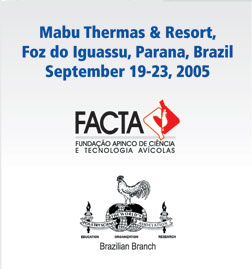Contributed Papers: Oral Presentations
Cell Biology |
CHARACTERISTIC
OF CRYPTOSPORIDIUM APICAL ANTIGENS USING CHICKEN MONOCLONAL
ANTIBODIES AGAINST Eimeria
M. Matsubayashi1, K. Sasai2*, I. Kimata3,
H. Matsuda4,
H. S. Lillehoj5, M. Iseki6, H. Tani2, E. Baba2
1. Department of Food and Nutrition, Osaka Yuhigaoka
Gakuen Junior College, Osaka 543-0073, Japan.
2. Department of Veterinary Internal Medicine, Division
of Veterinary Science, Graduate School of Life and
Environmental Sciences, Osaka
Prefecture University, Osaka 599-8531, Japan.
3. Department of Protozoal Diseases, Graduate
School of Medicine, Osaka City University, Osaka 545-8585,
Japan.
4. Laboratory of Immunobiology, Department of Molecular
and Applied Biosciences, Graduate School of Biosphere
Sciences, Hiroshima University,
Higashi-Hiroshima 739-8528, Japan. 5. U.S.
Department of Agriculture, Animal Parasitic Diseases
Laboratory, Animal and Natural Resources Institute,
BARC-East, 20705, Beltsville, MD, USA. 6. Department
of Parasitology,
Graduate School of Medical Science, Kanazawa University,
Kanazawa 920-8640, Japan.
* Corresponding author
Kazumi Sasai
E-mail: ksasai@vet.osakafu-u.ac.jp
Cryptosporidium is a coccidian
parasite that causes diarrhea in human and other animals.
Although Cryptosporidium represents a pathogen of
importance to the health of humans and animals, there
are no effective drugs and vaccines. In the previous
study, we have developed chicken monoclonal antibodies
(mAbs) against Eimeria acervulina and demonstrated
their use in the identification of potential vaccine
antigens for avian coccidiosis. Furthermore, we found
that these antibodies cross reacted with Cryptosporidium
parasites. In the present study, we characterized
the antigen of Cryptosporidium, which was recognized
by one of these chicken mAbs, 6D-12-G10. In indirect
immunofluorescent analysis, the chicken mAb 6D-12-G10
showed intense staining on the apical region of C.
parvum and C. muris sporozoites, and merozoites of
C. parvum. In western blot analysis, 6D-12-G10 antibody
identified a 48-kDa molecular weight band of C. parvum
and C. muris soluble antigens. Furthermore, the mAb
6D-12-G10 significantly inhibited the invasion of
C. parvum sporozoites into HCT-8 cells in vitro. Immunoelectron
microscopy revealed that the antigen recognized by
this mAb was located only at the apical surface membrane
of the invasive stages of C. parvum. Additionally,
we compared the antigen specificity of mAb 6D-12-G10
with several anti-cytoskeletal (actin, myosin, a-,
ß-, ?-tubulin) antibodies, and the reactivity
of mAb 6D-12-G10 was clearly different from those
of anti-cytoskeletal antibodies. These results indicate
that the target antigen recognized by mAb 6D-12-G10
is a good vaccine candidate for Cryptosporidium infection.
